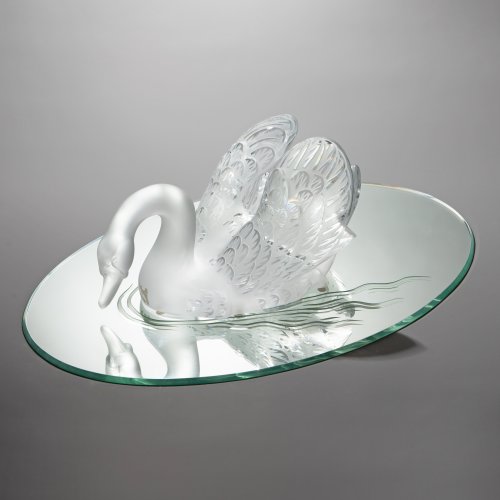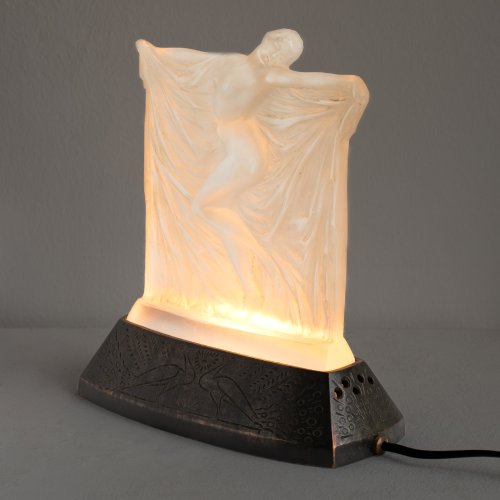Biography
In 1872 Lalique began his drawing education from the teacher Jean-Marie Leguien in the Turgot College. In the following four years he also learned techniques of jewelry-making and continued his drawing training at the École des Arts Décoratifs in Paris. A two-year study visit to London shaped his characteristic drawing style, which was based on natural forms and would later become important for his jewelry. When he returned to Paris, he began to make jewelry designs for various jewelers that quickly found buyers. Cartier was one of the top addresses among Parisian jewelers who appreciated his new designs. Towards the end of 1885, Lalique took over a small workshop to make his own jewelry and then went new ways. Contrary to popular belief, he attached little importance to valuable materials such as gold, pearls and precious stones. Above all, the artistic work was important to him, so cheaper materials such as enamel, ivory, horn, ordinary stones or glass were used.
"The search for the beautiful is more important than the display of luxury." Despite the simple materials, Lalique’s jewelry was very well received by the public, so that in 1890 he was able to open his own shop in a prestigious location. In 1894 he began to make stage jewelry for the actress Sarah Bernhardt. Lalique's jewelry clearly shows the influence of Art Nouveau, which was very interested in everything organic, botanical and creative, and in which animals, with a symbolic meaning, were also of great importance. Art Nouveau also loved metamorphosis, the hybrid creatures that arise from animals and humans or plants and humans. In 2016, Quittenbaum auctioned the unusual pendant 'Femme chauve souris', a nude girl with bat wings in gold and enamel. This wonderful design by Lalique attracted many bidders and was ultimately sold for 65,000 euros. The high quality jewelry of Lalique rarely find their way onto the art market.
From 1908, Lalique increasingly turned to glass art. At this time, he made perfume bottles for the perfumer François Coty for the first time. He rented a studio for glass work in Combs-la-Ville. In 1911, at a large sales exhibition in Paris, Lalique presented exclusively works made of glass for the first time. From this point on he gave up jewelry and devoted himself entirely to glass art.
During the First World War, Lalique had utility glass made for the pharmaceutical industry in his Combs-la-Ville workshop. After the war, he returned to handcrafted glass production. In 1921 he opened another factory in Wingen-sur-Moder, which is still the production site of the Lalique company.
At the 1925 arts and crafts exhibition in Paris, the term Art Deco was used for the style to which many of the works and products made by Lalique since 1920 belong to. In the following years Lalique participated in the design of important churches, public buildings and department stores. His company designed and manufactured hood ornaments for the car brands Citroën, Bentley, Bugatti, Hispano-Suiza, Rolls-Royce and Voisin. Lalique vases, bottles and glass figures were known and sought after all over the world. In the second half of the 1930s, Lalique was at the peak of his success as an artistic entrepreneur.
Cire-Perdue - Lalique’s glass work is a sought-after collector's item that can be found in all shapes and colors on the market. Among them may be real treasures like the unique lidded box that was offered by Quittenbaum in November 2017. It was a 'cire-perdue', which literally means lost wax. In the so-called lost wax process, both the model and the cast are destroyed during the casting and a unique, un-recreatable object remains. Such a rare find accumulated a lot of interest and resulted in a sale of 28,000 euros. In other processes, the mold can be reused over and over again, or there is the possibility to produce new molds using a model.
Although some models of Laliques were produced in large numbers, there are considerable differences between the pieces. Since every object is ground, polished or matted by hand, qualitative differences can be seen between the pieces made from the same models. Works in colored glass and with an opalescent surface are particularly popular due to their rarity. The age of the piece also plays a role in determining the value. The signature helps to narrow down the creation period and determine the authenticity.


